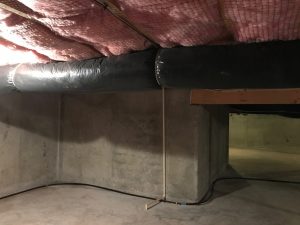How to Insulate Unvented Crawl Spaces
By Mark J. Donovan
|
|
If you are tired of having a damp and humid crawl space and having to open and close crawl space vents that never really seem to make a difference, then you may want to consider converting your crawl space into an unvented crawl space. The key components necessary to convert a vented crawl space into an unvented one is the introduction of insulation, a vapor barrier, and heat into the crawl space.
Insulating unvented crawl spaces enables the crawl space to effectively become an extension of a basement, or effectively a half-height basement. Like a basement, an insulated unvented crawl space is not exposed to the outside air temperatures and humidity levels. |
And when insulated and protected from ground moisture permeation, an unvented crawl space can become a useful and useable space for storing items.
Insulating Unvented Crawl Space Materials
Insulating unvented crawl spaces is a project that most do-it-yourself homeowners can tackle and the materials required are relatively inexpensive. To insulate an unvented crawl space, you will need; caulk, faced fiberglass batt or rolled insulation with an R-value of R-19, a vapor barrier (large sheets of 6 mil polyethylene plastic), duct tape, and some sand and gravel. In addition, you will also want to dress appropriately when insulating a crawl space. Make sure to wear clothes that cover your entire body and wear gloves, goggles and a mask to protect yourself from the fiberglass insulation.
By installing a vapor barrier on the floor of the crawl space the humidity levels in the crawl space will be dramatically reduced and thus prevent the insulation from becoming damp and moldy.
| Next, assuming a portion of the crawl space has framed knee walls, install the faced fiberglass roll or batt insulation in-between the wall stud bays by sliding it up snuggly against the wall sheathing. The faced side of the insulation should face inwards towards the crawl space. If the crawl space does not have framed knee walls then install pieces of batt/role insulation into the header and stringer bay areas, next to the band joists.
For the concrete, or masonry sections of the crawl space walls install faced batt/rolled insulation, or rigid foam insulation up against them, again with the faced insulation facing inwards towards the crawl space room. |
 |
Hold the batt/rolled insulation in place by nailing a narrow furring strip to the mudsills where the top of the insulation is sandwiched in-between. Make sure the insulation extends down onto the floor of the crawl space and overlaps the crawl space floor by a couple of feet. Use 2x4s to hold the batt/rolled insulation in place up against the wall.
Finally, introduce heat into the crawl space to allow the insulated unvented crawl space to have some semblance of warmth, similar to a basement.
For more help on Basement Additions, see HomeAdditionPlus.com’s Basement Remodeling Bid sheet. The Basement Remodeling Bid Sheet will help ensure that your hire the right contractor so that your basement remodeling project is done correctly and you get the project finished on time and budget.
Related Information
Get Free Basement Remodeling Price Quotes with No Obligation!
Fill out our 3-5 minute quick and easy form, and receive a free price quote on basement remodeling from one of our prescreened and licensed basement remodeling contractors. This process is free and there is no obligation to continue once you receive your basement remodeling price estimate.

